Completing Assignments
Take a Timed Exam
Timed exams are indicated on the Course page by a clock icon and the label Timed Exam.

After you begin taking a timed exam, a timer on the course page displays the amount of time that you have remaining to complete the exam. You cannot pause or reset a timed exam. When there is no time remaining, the course page automatically submits your exam.
You can request additional time to complete a timed exam. Course teams and instructors can increase the time allowed for individual learners to accommodate specific needs. You can only request additional time before you start a timed exam. Learn how to request additional time for an exam.
The time limit for an exam applies to all of the units in an exam section. If an exam includes problems on multiple unit pages, you must complete the problems on each unit page before you submit the exam or before the time runs out.
Note: You must select Submit to score the problems in each unit of an exam. If you submit an exam without selecting Submit in a unit, your exam results will not include scores for any of the problems in that unit.
To take a timed exam, follow these steps.
- Open the timed exam page in the course.
- Find the length of the time limit on the exam page. Make sure that you have enough time available to complete the exam. You will not be able to pause or restart the exam after you begin.
- Select I am ready to start this timed exam.
- Complete the problems in each unit of the exam. Select Submit to score the problems in the unit. If you do not select Submit, your responses will not be scored.
- Monitor the amount of time remaining in the time display at the top of the course page. When 20% of the time remains, the time display bar darkens to alert you. When 5% of the time remains, the text on the time display bar becomes bold.
Note: You can hide the amount of time that remains in your exam. To do this, select the icon that is located next to the timer. To show the remaining time, select the icon again.
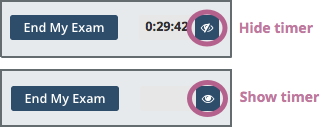
- After you have completed and checked all the units in the exam, select End My Exam at the top of the course page. If you run out of time, the exam will end automatically.
Request Additional Time on an Exam
You can request additional time to complete a timed exam. Course teams and instructors can increase the time allowed for individual learners to accommodate specific needs.
Note: You can only request additional time before you begin a timed exam. After you start an exam, the course team cannot allow more time for that exam attempt.
Course teams decide whether or not to grant additional time based on the criteria that they choose. You can get information about the availability of additional time from your course team.
Explain Multiple Choice Answers
If you encounter a multiple choice question that is followed by a field for an explanation, there are actually several more steps that you need to complete for the assignment. These assignments involve sharing what you have learned with other people in your online course. They give you an opportunity to learn from each other.
In a classroom setting, this type of assignment is sometimes called a “peer instruction” or “clicker” question. To complete this type of assignment, follow the steps below:
- Select an answer to the question.
- Write an explanation for why you chose your answer. You might include references to a course video or textbook, or describe how you arrived at the choice you made. Together, the answer that you chose and this explanation are your initial response. Click Next Step.
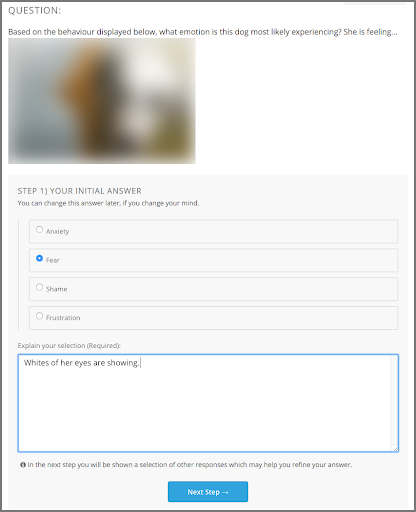
- Review the initial responses that other participants in the course submitted. The course team decides how many you see. You might see one response for each of the possible answer choices, or a set that is chosen completely at random. This step gives you a chance to learn from the explanations that other learners submitted, and reassess your own understanding of the topic. Because they are part of the collection of initial responses, your answer and explanation are likely to be shown to other learners when they get to this part of the assignment. Names are not shown with the responses.

- Decide whether you want to change your initial response by selecting a different answer choice, revising your explanation, or both. This step is optional. You can submit a final response that is the same as your initial response, or change it completely. When you select Next Step, you learn the correct answer.
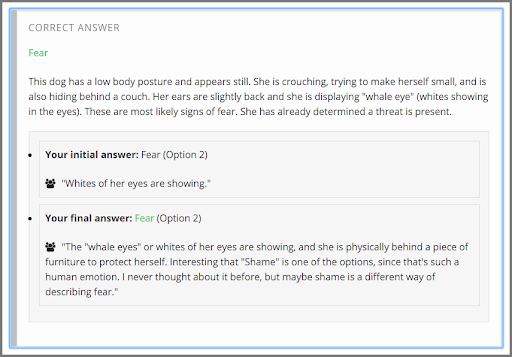
- Use the graphs to compare the percentage of your fellow learners who selected each answer. The first graph shows the percentage of learners who selected each answer initially, and the second graph shows the percentage of learners who selected each answer after they had the opportunity to review the explanations that other learners provided. Compare your own choices, and the correct one, to your peers’.
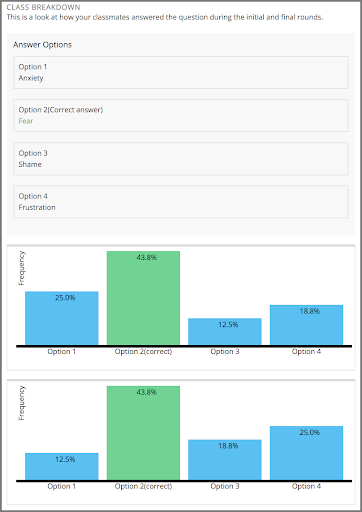
Request an Extension
Depending on the assignment type and the situation, your course staff may be able to provide a short extension for individual assignments. Please reach out to your course team directly with any contact information they provide within the course, or post on the course discussion forum.
It is certainly possible to pass a UC San Diego Online course if you miss some assignments; however, coursework is progressive, so you should review and study what you may have missed.
Some courses automatically drop one or more of your lowest graded assignments. Check your course syllabus for important dates and more information.
Enter Math Expressions in Assignments or the Calculator
You might want to enter a mathematical or scientific expression into an assignment, into the calculator tool in your course, or into a course discussion.
For assignments in the body of the course and for the calculator tool, you enter plain text, and your text is automatically converted into numbers and symbols that appear below the response field.
Entering math expressions in course discussions is different from entering math expressions in a math problem or in the calculator. In course discussions, you use MathJax to format the text that you type.
Note : For information about using screen readers in assignments containing mathematical expressions, see Completing mathematical problems using screen readers .
Both the calculator and the response fields in math problems accept a selection of characters that represent numbers, operators, constants, functions, and other mathematical concepts. You might recognize parts of this system if you have used math programs before.
If your course offers the calculator tool, the calculator appears as a small icon on all pages in the body of the course. To open the calculator, select the calculator icon. To close the calculator, select the X that appears when the calculator is open.
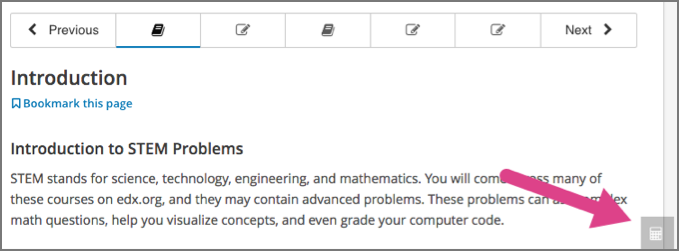
The calculator includes an information page that shows an abbreviated version of the information in this topic. To see the information page, select the circled i icon next to the input field.

Plain text guidelines
When you enter your plain text into the calculator or the response field, follow these guidelines.
- Arithmetical operations: Use standard characters for addition (+), subtraction (-), multiplication (*), and division (/).
- Multiplication: Be sure to indicate multiplication explicitly. That is, instead of mc^2 type m*c^2, and instead of 5a+4b+3c type 5*a+4*b+3*c.
- Operation order: Use parentheses (( )) to specify the order of operations and to make your expression as clear as possible. Use curved parentheses (( )) only. Do not use brackets ([ ]) or braces ({ }).
- Exponents or superscripts: Insert a caret (^) before an exponent or superscript. If the exponent or superscript includes multiple characters or is an expression, surround the expression with parentheses. For example, you can enter x^n or x^(n-1).
- Subscripts: Insert an underscore (_) before a subscript to indicate a subscript. If the subscript has multiple characters, type the characters without a space. For example, you can enter v_IN-v_OUT. Note, however, that subscripts cannot currently include operators or parentheses.
- Avoid whitespace.
- Do not use equal signs (=).
- Because the system is case-sensitive, make sure you use uppercase and lowercase letters carefully.
Note: Be careful to distinguish between constants and metric affixes. Constants stand alone, while metric affixes must be combined with numbers. For example, c can be a constant representing the speed of light or a metric affix meaning “centi”. When you use c as a metric affix, do not include a space between c and the number. When you use c as a constant, indicate multiplication explicitly. The following examples show the difference:
- 2c = 0.02 (2 multiplied by 0.01)
- 2*c = 599584916.0 (the speed of light multiplied by 2)
- 2M = 2,000,000 (2 multiplied by 1,000,000)
- 2*M = 2 multiplied by the variable M
Complete Mathematical Problems Using Screen Readers
Open edX—the system UC San Diego Online is based on—has carefully designed assessments that are accessible to screen readers. However, because of a limitation with HTML and screen reader technology, you may not be able to read all math problems on UC San Diego Online problems using a screen reader.
To access math problems with a screen reader, use one of the following methods.
- If your browser and screen reader both support MathML, specify MathML as your preferred math renderer in MathJax.
- Switch from your screen reader’s Interactive mode to Reading mode.
Note: Your screen reader may use different names for Interactive mode and Reading mode.
- In Interactive mode, use the Tab key to move from one interactive element to the next.
- In Reading mode, use the arrow keys to read all of the content in a document, and not just the interactive elements.
For more information about how to make sure that your screen reader reads all available content, see the instructions for your screen reader.
Learn how to enter math expressions and scientific expressions in assignments or the calculator.
Numbers in Math Expressions
When you complete assignments, you can use the following types of numbers in math expressions:
- Integers - for example, 2520
- Fractions - for example, 2/3
- Decimals - for example, 3.14 or .98
The largest number you can use is 1.7977e+308, which is the largest float possible in the Python programming language.
Learn how to enter math expressions and scientific expressions in assignments or the calculator or enter math expressions in course discussions.
Functions in Math Expressions
To use a function, type the letters that represent the function, and then surround the expression in that function with parentheses. For example, to represent the square root of 4*a+b, type sqrt(4*a+b).
You can use the following functions:
- Common functions:
- sqrt
- log10
- log2
- ln
- exp
- Abs
- Trigonometric functions and their inverses, as well as hyperbolic trigonometric functions and their inverses:
|
Function |
Inverse |
Hyperbolic Function |
Inverse |
|
sin |
arcsin |
sinh |
arcsinh |
|
cos |
arccos |
cosh |
arccosh |
|
tan |
arctan |
tanh |
arctanh |
|
sec |
arcsec |
sech |
arcsech |
|
csc |
arccsc |
csch |
arccsch |
|
cot |
arccot |
coth |
arccoth |
- Factorials: Enter factorials as fact(3) or factorial(3). You must use integers. For example, you cannot enter fact(1.5).
- A “parallel resistors” operator (||). For example, 1 || 2 represents the resistance of a pair of parallel resistors (of resistance 1 and 2 ohms), evaluating to 2/3 (ohms).
Learn how to enter math expressions and scientific expressions in assignments or the calculator or enter math expressions in course discussions.
Constants in Math Expressions
You can use several different constants in your mathematical expressions.
Note: When you enter constants multiplied by a number, make sure to indicate the multiplication explicitly. For example, enter 2*c instead of 2c, and enter -4*i instead of -4i.
|
Constant |
Value |
|
C |
The speed of light in m/s (2.998^8) |
|
e |
Euler’s number (2.718…) |
|
g |
Gravity (9.80 m/s^2) |
|
i |
The square root of -1 |
|
j |
The square root of -1 |
|
k |
The Boltzmann constant (~1.38^-23 in Joules/Kelvin) |
|
pi |
The ratio of a circle’s circumference to its diameter (3.14159…) |
|
q |
The fundamental charge (~1.602^-19 Coloumbs) |
|
T |
The positive difference between 0K and 0°C (273.15) |
Learn how to enter math expressions and scientific expressions in assignments or the calculator or enter math expressions in course discussions.
Scientific Notation and Metric Affixes
You can enter metric affixes or scientific notation to indicate very large or very small numbers. For scientific notation, you can type either a caret (^) or the letter e followed by a number to indicate an exponent. You can use both positive and negative exponents.
For example, to indicate 0.012, you can enter either of the following expressions:
- 1.2*10^-2
- 1.2e-2
To indicate -440,000, you can enter either of the following expressions:
- -4.4*10^5
- -4.4e5
The following table shows how to enter numbers with metric affixes, with scientific notation, and with e notation.
|
To enter this number |
Use this metric affix |
Scientific notation |
Use this e nnotation |
Other notation |
|
0.1 |
1d (deci) |
10^-1 |
1e-1 |
|
|
0.01 |
1c (centi) |
10^-2 |
1e-2 |
1% (percent) |
|
0.000001 |
1m (milli) |
10^-3 |
1e-3 |
|
|
0.00000001 |
1u (micro) |
10^-6 |
1e-6 |
|
|
0.0000000001 |
1n (nano) |
10^-9 |
1e-9 |
|
|
0.000000000001 |
1p (pico) |
10^-12 |
1e-12 |
|
|
1,000 |
1k (kilo) |
10^3 |
1e3 |
|
|
1,000,000 |
1M (mega) |
10^6 |
1e6 |
|
|
1,000,000,000 |
1G (giga) |
10^9 |
1e9 |
|
|
1,000,000,000,000 |
1T (tera) |
10^12 |
1e12 |
|
Note: When you use metric affixes or e notation, make sure you do not include spaces between the number and the metric affix or the e.
Learn how to enter math expressions and scientific expressions in assignments or the calculator or enter math expressions in course discussions.
Submit Button is Not Active
The submit button for an assignment will activate once you enter an answer for the assignment, unless the due date has passed. You can see the due date for an assignment under the segment name in the course outline.
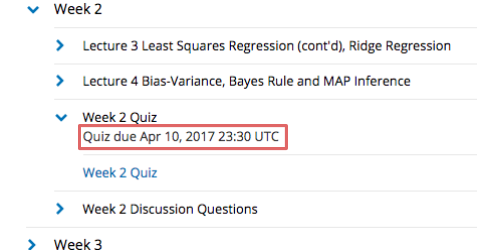
Next Button is Not Working
The Next and Previous buttons at the bottom of a course page will allow you to move through the course materials one unit at a time.
Once you reach the last unit in a course (or the last available unit in an instructor-paced course) the Next button will deactivate. If you are at the end of your course you can see your grading in the Progress tab.

In an instructor-paced course new contents are usually released each week. If you have not reached the last week of the course before the course end date, the Next button will reactivate on this unit once the new content is available.